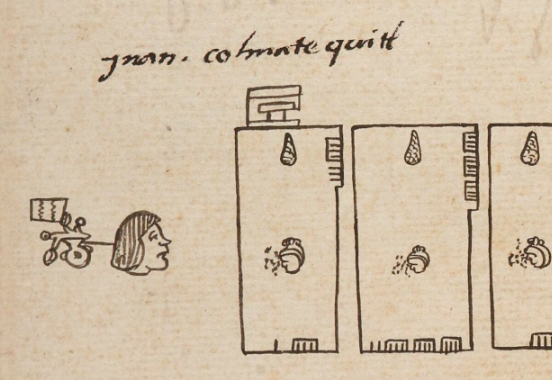coatequitl (Verg16r)
This black-line drawing of the compound glyph for the personal name coatequitl (“Tribute Labor,” attested here as a man’s name) includes three elements. In the lower right is a clay jug (comitl) providing the "Co-" phonetic start to the name. Coming out of the top of the container and bending to the left is a stream of water (atl) with four splashes and alternating droplets/bead and turbinate shells at the tips. Finally, in the upper left is a horizontal rectangle with two wavy lines dividing the rectangle into three approximately even portions or sections. This rectangle speaks to the part of the word that is -tequitl (work). This rectangle suggests a piece of woven cloth, but it might also be an agricultural field.
Stephanie Wood
In other appearances of this visual for tequitl, we have concluded that it refers more likely to a piece of cloth tribute than a land allotment. It resembles the cloth tribute from the Tepetlaoztoc manuscripts more than agricultural parcels. It is very much like the rectangle in the compound glyph for the place name, Yancuictlan, shown below.
Stephanie Wood
juan.cohuatequitl
Juan Coatequitl
1539
Jeff Haskett-Wood
cantaros, agua, telas, mantas, tributos, ollas, jarras

cohuatequi(tl), tribute labor, https://nahuatl.wired-humanities.org/content/cohuatequitl
Codex Vergara, folio 16r, https://gallica.bnf.fr/ark:/12148/btv1b84528032/f39.item.zoom
The non-commercial reuse of images from the Bibliothèque nationale de France is free as long as the user is in compliance with the legislation in force and provides the citation: “Source gallica.bnf.fr / Bibliothèque nationale de France” or “Source gallica.bnf.fr / BnF.” We would also appreciate a citation to the Visual Lexicon of Aztec Hieroglyphs, https://aztecglyphs.wired-humanities.org/.






